It looks like you're using an Ad Blocker.
Please white-list or disable AboveTopSecret.com in your ad-blocking tool.
Thank you.
Some features of ATS will be disabled while you continue to use an ad-blocker.
share:
Okay, since everyone is too lazy to go look at the data for themselves,
Here is Australia's data. New Zealand has recorded similar. I could do every single country but there is not enough space in a post to do so. The Aussie data is averages since 1910 on everything except evaoration and sea temperatures, which recording started in 1970.
I would also point out that our PM, Mr Abbott, is a climate change denier. The data has not been manipulated to suit an agenda as if it had been it would support Mr Abbot's view that we are imagining it all.
Min temp trend
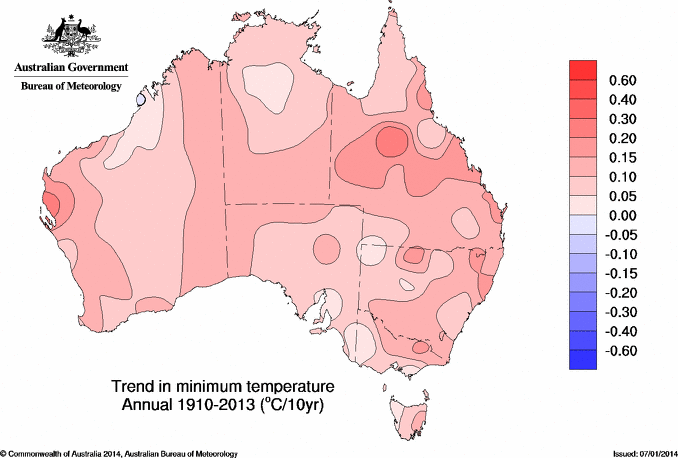
Max temp trend
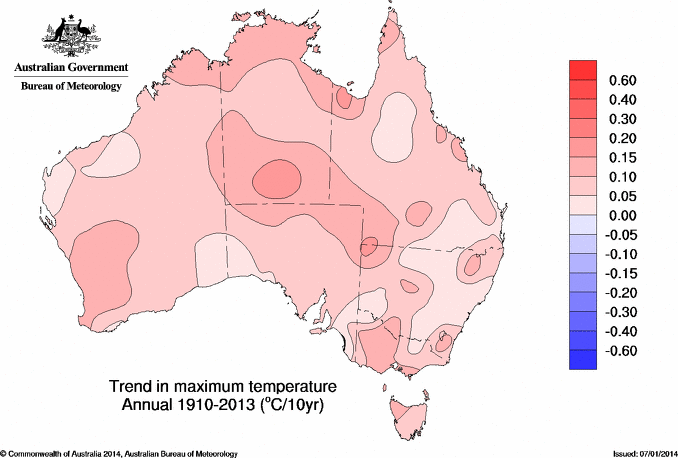
Mean temp trend
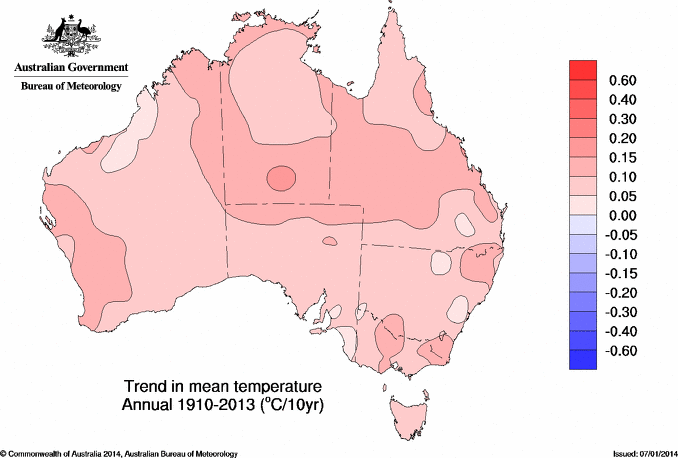
Evaporation trend
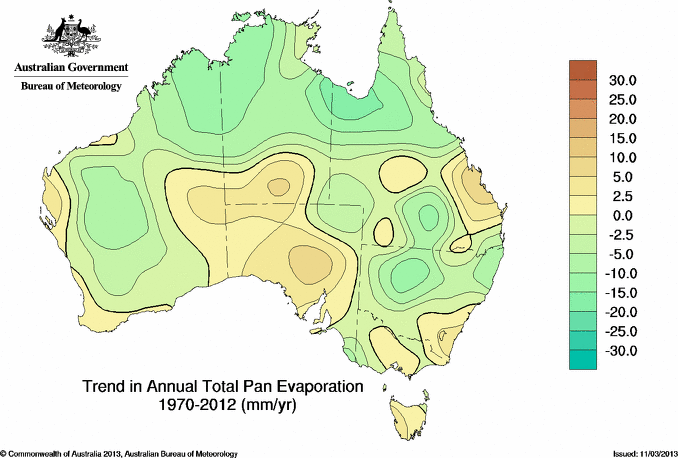
Sea temp trend
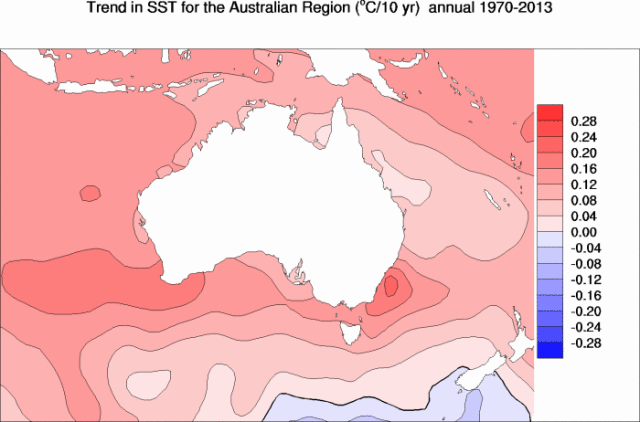
Here is Australia's data. New Zealand has recorded similar. I could do every single country but there is not enough space in a post to do so. The Aussie data is averages since 1910 on everything except evaoration and sea temperatures, which recording started in 1970.
I would also point out that our PM, Mr Abbott, is a climate change denier. The data has not been manipulated to suit an agenda as if it had been it would support Mr Abbot's view that we are imagining it all.
Min temp trend

Max temp trend

Mean temp trend

Evaporation trend

Sea temp trend

edit on 24-2-2014 by markosity1973 because: (no reason given)
edit on 24-2-2014 by markosity1973
because: (no reason given)
markosity1973
reply to post by talklikeapirat
Link to refute the hiatus theory, explaining where it started and why it is wrong here
The 'pause' in global warming is not even a thing
www.theguardian.com...
England told me:
Global warming has not stopped. People should understand that the planet is a closed system. As we increase our emissions of greenhouse gases, the fundamental thermal dynamics tells us we have added heat into the system. Once it's trapped, it can go to a myriad of places – land surface, oceans, ice shelves, ice sheets, glaciers for example.
BWAHAHAHAHAHAHAHAHA WTF!?????
The Earth is a closed system?
Oh wait he was serious?
Then what does he consider the energy from the Sun which is being "trapped" by the C02?
Okay, I can't take this guy or his study seriously at all, his model incorporated a known 20 year trend which other models failed to account for?
England's study found that climate models had not been geared to account for the current two decade-long period of strong trade winds in the Pacific.
Once the researchers added this missing windy ingredient to the climate models, the surface temperatures predicted by the models more closely matched the observations – that is, the actual temperature measurements that have been taken around the globe.
20 year trends are being ignored by so called climate modelers?
What is next?
Matching a Power Series to a Monte Carlo simulation which fails to predict future temps and claim it is accurate . . . . oh wait, that has already been happening
-FBB
edit on 24-2-2014 by FriedBabelBroccoli because: 101
CASE IN POINT REGARDING A "CLOSED SYSTEM"
Polar wind
en.wikipedia.org...
Polar wind or plasma fountain is the permanent outflow of ionized gas (plasma) from the polar regions of the magnetosphere,[2] caused by the interaction between the solar wind and the Earth's atmosphere. The solar wind ionizes gas molecules in the upper atmosphere to such high energy that some of them reach escape velocity and pour into space.
A considerable percentage of these ions remain bound inside Earth's magnetic field where they form part of the radiation belts.
This "scientist" should operating with bounds, leave that to the engineers . . . buddy.
edit on 24-2-2014 by FriedBabelBroccoli because:
202
I happen to think the sun generates just about everything on earth including cycles. That volcanoes are the things responsible for earth warming and
the push is from the sun. Amplified by whatever tesla type scalar waves and nukes they use. They turn the disaster dial up.
reply to post by jdub297
This new study reinforces earlier work showing that small volcanic eruptions can affect background levels of aerosols more than previously thought. From 2011:
www.sciencemag.org...
Actually, no. It has actually been analyzed in quite a bit of detail in the last IPCC report.
Ever since it was first recognized as a real phenomenon, the “pause” in global temperature increases (and increasing divergence from climate model projections), has been wished-away by the die-hard faithful, or explained-away by speculative grant-mongers, despite a complete lack of evidence, as migrating to the deep ocean waters.
So, the rising temperatures are due to increased solar irradiance? Are you talking about the Solar cycle, or something more profound? Something that factors into the warming trend that has been observed over the past 100 years, and more intensely over the past 50? Has solar irradiance increased? Is that what has caused the rise in temperatures? I'm sure you have supporting data if that's the case.
The article reported in Nature Geoscience also goes further, acknowledging decreased solar radiance and insolation as part of the explanation:
This new study reinforces earlier work showing that small volcanic eruptions can affect background levels of aerosols more than previously thought. From 2011:
Recent measurements demonstrate that the “background” stratospheric aerosol layer is persistently variable rather than constant, even in the absence of major volcanic eruptions.
www.sciencemag.org...
edit on 2/24/2014 by Phage because: (no reason given)
(post by jdub297 removed for a manners violation)
reply to post by jdub297
I guess you didn't read the full report then.
It was brushed off in the Summary, and largely ignored in the subparts. The only "detail" was speculation about deep-ocean heat sinks, and even that could not be dealt with in any "detail" due to the lack of long-term Argo records and analyses.
Yes, I know. So, what accounts for the rise in temperatures before the pause? Was there a sufficient increase in total solar irradiance to account for it?
The Nature GeoScience article refers to lower irradiance and atmospheric particulates as possible explanations for the well-recognized "pause."
The study is not about gases. It is about aerosols. It was previously thought that it took large volcanic eruptions to get enough aerosols into the stratosphere to affect radiative forcing. It is now apparent that smaller eruptions can do so.
Wow! Who would've guessed that the gas and aerosol mixture of the stratosphere is "variable rather than constant?"
edit on 2/26/2014 by Phage because: (no reason given)
markosity1973
reply to post by BayesLike
No-ones models are working as expected because;
a) What actually drives our weather systems is not yet fully understood. It is known that the oceans are where most of the weather is created, but the jet stream is what moves it around. Both we are still learning about how they interact and in particular with the jet stream we need to learn a lot more.
b) Unforseen variables like Mt Unpronouncable in Iceland blowing its stack and releasing huge amounts of ash into the atmohspere, causing a global drop in temperatures and the North Atlantic current faltering, causing freak winters in Northern Europe and East Coast USA
It's more than just oceans and jet stream -- and much more than a volcano or two. It's the lack of real physical science in the models combined with poor statistical procedures. The one set of climate runs I "participated" in for a while via BOINC was producing biased results because the supposed "researchers" invalidly excluded runs with the characteristic of not producing warming by 5 years (I think it was a 5 year test point with a known global average). This is a flat out stupid thing to do in
a simulation study. My understanding is this is commonly done -- and it's 100% wrong to do.
Phage
Yes, I know. So, what accounts for the rise in temperatures before the pause? Was there a sufficient increase in total solar irradiance to account for it?
Phage, I generally like your posts and often largely agree with them. I'm assuming, possibly incorrectly, that you are asking a somewhat rhetorical question here. Mostly because it is a known claim that solar irradiance effects are supposed to be too small to account for any meaningful warming or cooling. But that claim has to do with energy per square meter.
Assuming that the underlying effect that causes change in solar irradiance at all energies = known effects on climate is simply wrong. Solar change affects not only irradiance but solar wind, dust density in our local interplanatary space, coupling of the electromagnetics of the Earth and Sun, and much more. There is a possibility that all of these have some influence on cloud formation, which the climate models are particularly poor at dealing with. Changes in proportion of UV vs visible light may also affect cloud formation due to chemistry and bioactivity in the atmosphere. There is some evidence for all of this.
So, don't dismiss claims because of irradiance. It's not just energy per square meter. If the models were any good, they would show pauses, cooling, and warming to about the extent that those actually occur. That's what real physical models do. It's obvious the models are wrong therefore the models = bad science (or at best woefully incomplete science) and suffer from very poor methods.
If we go to basics, it's actually not even clear that a global average temperature has any particular meaning. It's quite possible the median plus particular deciles (10%, 90%) in temperature may be much more valid than the average for describing what is occurring or not occurring. Averages can move while the median stays put or goes the other direction. In addition, there are common cases where the average can increase or decrease while ALL the measurements do the opposite! Furthermore, two locations with the same average temperature do not have to have the same climate -- so average temperature is a questionable proxy for climate to begin with. Finally, the average reported today is biased to where we take the data -- and that is not (yet) evenly distributed about the entire planet nor are all the "accepted" measurements made with valid stations. Sweeping assumptions, probably wrong, have to be made to fill gaps in over 2/3 of the Earth's surface.
Lastly, statistical methods can deal with the noise in the data, but not the kind of bias practiced in picking and choosing which stations to "accept." Only stations with demonstrated known causes for being an outlier should be removed, not those which didn't fit some "pattern" which was presupposed by some researcher(s). The data and basis for excluding much historical data should have been open AND REPEATABLE by others.
When climate scientists clean up their act, get rid of the poor practitioners and chicken-little missionaries, and quit being blatantly political, they will be far more believable. At this point, I put climate science (especially IPCC) in my "junk science" drawer and do so for sound reasons.
reply to post by BayesLike
The recent pause does not indicate that the models are no good, it reiterates that that models are based on longer term trends. There was also a pause in warming in the middle of the 20th century. There have been other pauses, but the long term trend has been an increase and that increase falls within the parameters of the models.
The models are not perfect but they are not "no good".
Are you saying that the average global temperature is not rising? You just brought up pauses. If there are pauses, doesn't that mean there is a trend? If temperatures aren't rising, how can there be a pause?
The growing number of all time record high temperatures and declining number of all time low record temperatures indicates a warming trend. www.ncdc.noaa.gov...
What evidence? What evidence that such things can affect climate? What evidence that such things have changed in the past 100 years?
There is a possibility that all of these have some influence on cloud formation, which the climate models are particularly poor at dealing with.
The models can show pauses.
If the models were any good, they would show pauses, cooling, and warming to about the extent that those actually occur.
Furthermore, the timing of internal decadal climate
variability is not expected to be matched by the CMIP5 historical simulations, owing to the predictability horizon of at most 10 to 20
years (Section 11.2.2; CMIP5 historical simulations are typically started around nominally 1850 from a control run). However, climate
models exhibit individual decades of GMST trend hiatus even during a prolonged phase of energy uptake of the climate system (e.g.,
Figure 9.8; Easterling and Wehner, 2009; Knight et al., 2009), in which case the energy budget would be balanced by increasing
subsurface–ocean heat uptake (Meehl et al., 2011, 2013a; Guemas et al., 2013).
The recent pause does not indicate that the models are no good, it reiterates that that models are based on longer term trends. There was also a pause in warming in the middle of the 20th century. There have been other pauses, but the long term trend has been an increase and that increase falls within the parameters of the models.
The models are not perfect but they are not "no good".
If you consider extrapolation to be assumptions, but I don't know why you say they are probably wrong. So how do you recommend it be done?
Sweeping assumptions, probably wrong, have to be made to fill gaps in over 2/3 of the Earth's surface.
Are you saying that the average global temperature is not rising? You just brought up pauses. If there are pauses, doesn't that mean there is a trend? If temperatures aren't rising, how can there be a pause?
The growing number of all time record high temperatures and declining number of all time low record temperatures indicates a warming trend. www.ncdc.noaa.gov...
What makes you think it isn't.
The data and basis for excluding much historical data should have been open AND REPEATABLE by others.
You haven't provided them here. You first say that other things might be causing warming, indicating that warming is occurring. You say that models can't predict pauses in warming, indicating that warming is occurring. You then seem to be questioning that warming is even occurring. You contradict yourself in your effort to deny the evidence.
At this point, I put climate science (especially IPCC) in my "junk science" drawer and do so for sound reasons.
reply to post by Phage
Phage, I'd love to do the paper lookups for you but don't have the time at the moment. They do exist. I can provide hints you can use as search terms -- I'd go to Scholar or another paper or library search engine if possible that is more academic. Search hints include links between solar activity and cosmic rays, UV and atmospheric chemistry, UV and bioactivity. There is also a very recent paper regarding tree aerosols (pines so far) too which may end up being important; I haven't acquired that one yet but do plan to spend some time going over the sampling methods, data analysis, and conclusions.
Models which do not have a mean which behaves like the real phenomena are not good models. All the models we use in physics are mean behavior models. It's extremely rare to find models which address the structure of variation (that can be done). "Bounds" which encompass the totality of possible responses are pointless -- might just as well add noise to the output and say it covers the recent past adequately. No, a good scientist or engineer DOESN'T put trust in models whose mean behavior is wrong. One would only consider using such a model if desperate for some information and then all findings would be heavily qualified with 'If's" and "maybe's." Climate models have very clearly incorrect mean behavior. The climate models are at best very primitive and at worst simply very bad science. End of story.
Yeah -- they may start in the mid to late 1800's but my understanding is they usually end the "training" data 5 years or so early and project that 5 year period. Then the run is tested against the withheld real data to see if they should "allow" the run to proceed. Tossing those runs which do not meet acceptance criteria is a major NO NO for simulations. Either the model works or it doesn't. If it doesn't work properly, you spend your time and money on improving the models; not screaming doom and gloom to the media.
BTW: the picked start time is usually near the end of one of the two the last MAJOR cooling periods. For either, unless we headed into an ice age, we were pretty much going to warm up just to return to normal temperatures for this geologic epoch. That choice of starting times is a huge bias. Good models should be able to start at random times in the past and do just as well as starting at any other specific time. But, they don't even get the 5 year prediction with reasonable error without picking and choosing -- after being given a start with hugely biased starting conditions.
A scientist should always be a skeptic and look at research as a skeptic -- and always reassess prior conclusions when new data arrives. I would hope you do that in your field. I do in my fields. And I extend that courtesy when I read papers from other fields as well. Papers which do not use sound methods are always highly questionable; I do not put much weight on their so called findings. No reasonable person should. Climate change science, specifically the modeling results which tends to get coverage today, have used highly questionable methods. Methods which can lead to severe biases. Nor have they had open research nor have they have adequate peer review from others in even their own discipline who are not bought into the political hype. Climate science is as bad and is as biased as what shows up masquerading as science in most medical journals.
I will firmly restate: IMO, most climate science published today is junk science. We aren't at the point in model development where any valid conclusion can be drawn. The mean behavior is wrong and the models are next to worthless. IMO, yes, fund some research into improving the models but that funding should REQUIRE a) sound methods and b) not permit funding the current set of researchers without documented reeducation and endorsement of sound scientific methods and analysis.
Phage, I'd love to do the paper lookups for you but don't have the time at the moment. They do exist. I can provide hints you can use as search terms -- I'd go to Scholar or another paper or library search engine if possible that is more academic. Search hints include links between solar activity and cosmic rays, UV and atmospheric chemistry, UV and bioactivity. There is also a very recent paper regarding tree aerosols (pines so far) too which may end up being important; I haven't acquired that one yet but do plan to spend some time going over the sampling methods, data analysis, and conclusions.
Models which do not have a mean which behaves like the real phenomena are not good models. All the models we use in physics are mean behavior models. It's extremely rare to find models which address the structure of variation (that can be done). "Bounds" which encompass the totality of possible responses are pointless -- might just as well add noise to the output and say it covers the recent past adequately. No, a good scientist or engineer DOESN'T put trust in models whose mean behavior is wrong. One would only consider using such a model if desperate for some information and then all findings would be heavily qualified with 'If's" and "maybe's." Climate models have very clearly incorrect mean behavior. The climate models are at best very primitive and at worst simply very bad science. End of story.
Yeah -- they may start in the mid to late 1800's but my understanding is they usually end the "training" data 5 years or so early and project that 5 year period. Then the run is tested against the withheld real data to see if they should "allow" the run to proceed. Tossing those runs which do not meet acceptance criteria is a major NO NO for simulations. Either the model works or it doesn't. If it doesn't work properly, you spend your time and money on improving the models; not screaming doom and gloom to the media.
BTW: the picked start time is usually near the end of one of the two the last MAJOR cooling periods. For either, unless we headed into an ice age, we were pretty much going to warm up just to return to normal temperatures for this geologic epoch. That choice of starting times is a huge bias. Good models should be able to start at random times in the past and do just as well as starting at any other specific time. But, they don't even get the 5 year prediction with reasonable error without picking and choosing -- after being given a start with hugely biased starting conditions.
A scientist should always be a skeptic and look at research as a skeptic -- and always reassess prior conclusions when new data arrives. I would hope you do that in your field. I do in my fields. And I extend that courtesy when I read papers from other fields as well. Papers which do not use sound methods are always highly questionable; I do not put much weight on their so called findings. No reasonable person should. Climate change science, specifically the modeling results which tends to get coverage today, have used highly questionable methods. Methods which can lead to severe biases. Nor have they had open research nor have they have adequate peer review from others in even their own discipline who are not bought into the political hype. Climate science is as bad and is as biased as what shows up masquerading as science in most medical journals.
I will firmly restate: IMO, most climate science published today is junk science. We aren't at the point in model development where any valid conclusion can be drawn. The mean behavior is wrong and the models are next to worthless. IMO, yes, fund some research into improving the models but that funding should REQUIRE a) sound methods and b) not permit funding the current set of researchers without documented reeducation and endorsement of sound scientific methods and analysis.
reply to post by Phage
Both the U.S. and U.K. "science academies" (political organizations) have joined in statements acknowledging the "pause" and the effects of solar irradiamce in climate, as well as the failure of the models to account for the mid-20rh Century and late 20th pauses.
www.reuters.com...
Even the most ardent "deniers" of the hiatus acknowledge that GCMs were not able to anticipate it until they were tweaked and re-tweaked to account for it -- after the fact.
www.theguardian.com...
A "two decade-long" phenomenon, (now) recognized to strongly affect surface observations, that no "climate scientist" took into account (until now)?
One has to ask, "What else have they 'overlooked' or excluded from consideration because it didn't figure into their (faulty/biased) assumptions?"
The models are "no good" unless altered in hindsight until they approximate observation; usually to include factors previously, and consciously, excluded from consideration because they did not fit the "consensus" or conventional wisdom.
That is not "science," it is fakery at its worst.
Both the U.S. and U.K. "science academies" (political organizations) have joined in statements acknowledging the "pause" and the effects of solar irradiamce in climate, as well as the failure of the models to account for the mid-20rh Century and late 20th pauses.
(Reuters) - A slowdown in the pace of global warming so far this century is likely to be only a pause in a longer-term trend of rising temperatures, the science academies of the United States and Britain said on Thursday.
Since an exceptionally warm 1998, there has been "a short-term slowdown in the warming of Earth's surface," Britain's Royal Society and the U.S. National Academy of Sciences said in a report.
…
The warming hiatus may be caused by shifts in the oceans that are absorbing more heat from the atmosphere, the report said. Other studies suggest that sun-dimming volcanic eruptions or a lower output from the sun may contribute.
www.reuters.com...
Even the most ardent "deniers" of the hiatus acknowledge that GCMs were not able to anticipate it until they were tweaked and re-tweaked to account for it -- after the fact.
England's study found that climate models had not been geared to account for the current two decade-long period of strong trade winds in the Pacific.
www.theguardian.com...
A "two decade-long" phenomenon, (now) recognized to strongly affect surface observations, that no "climate scientist" took into account (until now)?
One has to ask, "What else have they 'overlooked' or excluded from consideration because it didn't figure into their (faulty/biased) assumptions?"
The models are "no good" unless altered in hindsight until they approximate observation; usually to include factors previously, and consciously, excluded from consideration because they did not fit the "consensus" or conventional wisdom.
That is not "science," it is fakery at its worst.
edit on 1-3-2014 by jdub297 because: What else have they 'overlooked'
Phage
reply to post by jdub297
I guess you didn't read the full report then.
It was brushed off in the Summary, and largely ignored in the subparts. The only "detail" was speculation about deep-ocean heat sinks, and even that could not be dealt with in any "detail" due to the lack of long-term Argo records and analyses.
Yes, I know. So, what accounts for the rise in temperatures before the pause? Was there a sufficient increase in total solar irradiance to account for it?
The Nature GeoScience article refers to lower irradiance and atmospheric particulates as possible explanations for the well-recognized "pause."
The study is not about gases. It is about aerosols. It was previously thought that it took large volcanic eruptions to get enough aerosols into the stratosphere to affect radiative forcing. It is now apparent that smaller eruptions can do so.
Wow! Who would've guessed that the gas and aerosol mixture of the stratosphere is "variable rather than constant?"
edit on 2/26/2014 by Phage because: (no reason given)
I've read the Summary and the Working Groups reports. Despite your misrepresentation and pretension, they did not account for a pause.
The problem that Spiegel describes seems to be one where the observed data was allowed to speak for itself to the public before the scientists ever got the chance to repackage it to their liking.
Spiegel writes, quoting Ed Hawkins of the University of Reading:
"Since 1990 in its 5 reports the UN IPCC failed somewhat to provide clear details over the possibilities of a slowdown in warming. Studies on this were ‘first published after the pause’.”
Bojanowski looks into why this is so. In a nutshell: That a slowdown in warming was possible never even occurred to the scientists. Reality caught them with their pants down.
He writes:
"Climate models had never expected the pause: Only 3 of 114 climate simulations were able to reproduce the trend of the past years, the IPCC concludes in its latest report. The reason for the deviation between models and observations is unclear.”
Bojanowski then presents some of the explanations now being floated for the “pause”: volcanoes, Pacific trade winds, heat hidden deep in the ocean, PDO, solar activity, Chinese air pollution, and even “faulty” methodology for computing the global temperature (it’s warming after all).
Spiegel On 15-Year Pause: “Biggest Mystery In Climate Science” … Scientists Caught With Their Pants Down
Pretend all you want; "climate scientists" are still guessing, at best, why they've failed so miserably.
reply to post by jdub297
Is this the same Santer et al that also made this statement:
So taking that above published scientific assertion into account:
Now that it's been 16-17 years of an overall warming pause... is it safe to say, therefore, that human effects on climate may not be as significant as previously thought ?
... Or does this minimum 17-year confirmation thing only work in one direction ?
Is this the same Santer et al that also made this statement:
A single decade of observational TLT data is therefore inadequate for identifying a slowly evolving anthropogenic warming signal. Our results show that temperature records of at least 17 years in length are required for identifying human effects on global-mean tropospheric temperature.
Journal of Geophysical Research
So taking that above published scientific assertion into account:
Now that it's been 16-17 years of an overall warming pause... is it safe to say, therefore, that human effects on climate may not be as significant as previously thought ?
... Or does this minimum 17-year confirmation thing only work in one direction ?
reply to post by jdub297
Um. No. That is science.
Science functions by adjusting theory to match data. That's how it works.
Computer models are refined by adjusting them to match real world data. That's how it works.
That is not "science," it is fakery at its worst.
Um. No. That is science.
Science functions by adjusting theory to match data. That's how it works.
Computer models are refined by adjusting them to match real world data. That's how it works.
edit on 3/1/2014 by Phage because: (no reason given)
reply to post by CranialSponge
No. But you did notice that the statement was "at least". I see that you understand that is talking about a minimum. I see you understand that a trend cannot be determined by a minimum span, that it requires looking at longer time periods.
I'm sure you understand that there is quite a bit more than 17 years of data which shows an overall warming trend, during which there has been more than one pause.
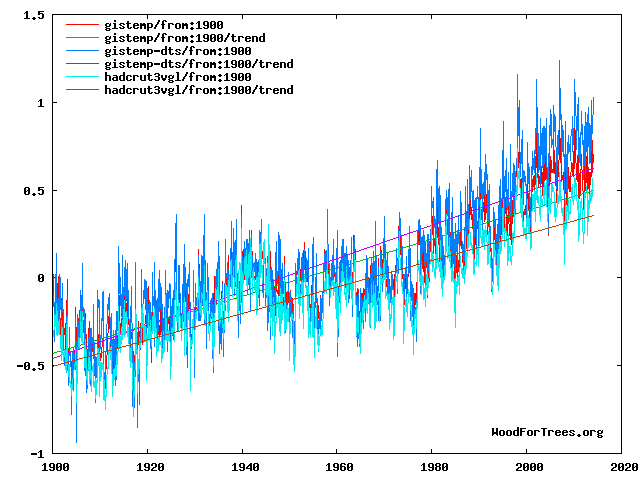
Or does this minimum 17-year confirmation thing only work in one direction ?
No. But you did notice that the statement was "at least". I see that you understand that is talking about a minimum. I see you understand that a trend cannot be determined by a minimum span, that it requires looking at longer time periods.
I'm sure you understand that there is quite a bit more than 17 years of data which shows an overall warming trend, during which there has been more than one pause.

edit on 3/1/2014 by Phage because: (no reason given)
reply to post by Phage
It's not my fault that these scientists keep putting their feet in their mouths by making ridiculous assertions in their studies...
Yes, it's interesting to see the pause on your graph... particularly how it happened during a time when the CO2 ppm levels were still at "safe levels".
But now (40 years later) that we've got these "scary" levels of CO2 climbing at an out of control rate increase, how is it possible for yet another "pause" to happen at all ?
From your same source, here's a look at the 17 year pause thus far:
What if this pause continues for another 17 years ?
How would they back peddle from that ?
What if their estimated warming trend predicted through to 2100 never comes back to full fruition ?
Based on the understanding that the sun was going into a lull at that time many years ago, they didn't expect any potential pause to last more than a decade. Well, we're now heading into 2 decades worth of a pause...
And since the sun has such a "minimal effect" on our climate (per IPCC AR reports), are the mysterious workings of volcanoes to blame for these past 17 years ? Surely, you see how ridiculous this sounds just like I do.
How long before they finally admit that they've way overestimated climate/CO2 sensitivity, and their 50+ year outlook has been nothing but hyperbolic faulty assumptions ?
The models fail, and they will continue to fail so long as these scientists continue to ignore so many other mechanisms involved in climate influence:
- Solar radio flux
- UV irradiance
- Oceanic volcanism
- Ionized particles
- Heliospheric fluctuations
- Solar and geo magnetics
- Cosmic ray fluctuations
- Bio off-gassing
- Hydrological cycling fluctuations
etc etc.
It's not my fault that these scientists keep putting their feet in their mouths by making ridiculous assertions in their studies...
Yes, it's interesting to see the pause on your graph... particularly how it happened during a time when the CO2 ppm levels were still at "safe levels".
But now (40 years later) that we've got these "scary" levels of CO2 climbing at an out of control rate increase, how is it possible for yet another "pause" to happen at all ?
From your same source, here's a look at the 17 year pause thus far:
What if this pause continues for another 17 years ?
How would they back peddle from that ?
What if their estimated warming trend predicted through to 2100 never comes back to full fruition ?
Based on the understanding that the sun was going into a lull at that time many years ago, they didn't expect any potential pause to last more than a decade. Well, we're now heading into 2 decades worth of a pause...
And since the sun has such a "minimal effect" on our climate (per IPCC AR reports), are the mysterious workings of volcanoes to blame for these past 17 years ? Surely, you see how ridiculous this sounds just like I do.
How long before they finally admit that they've way overestimated climate/CO2 sensitivity, and their 50+ year outlook has been nothing but hyperbolic faulty assumptions ?
The models fail, and they will continue to fail so long as these scientists continue to ignore so many other mechanisms involved in climate influence:
- Solar radio flux
- UV irradiance
- Oceanic volcanism
- Ionized particles
- Heliospheric fluctuations
- Solar and geo magnetics
- Cosmic ray fluctuations
- Bio off-gassing
- Hydrological cycling fluctuations
etc etc.
reply to post by jdub297
Neptune is a huge planet in the outer reaches of our solar system. It is located so far away from our sun that our sun, viewed from Neptune, would look like a bright star.
How Does The Sun Appear On Other Planets?
Neptune is also experiencing global warming.
Suggestive correlations between the brightness of Neptune, solar variability, and Earth's temperature
Climate Change on Neptune 1920 - 2002
Pluto is a tiny place much further from our sun than even Neptune. Our sun, from Pluto, would look like a bright star. Pluto is also experiencing warming.
Global Warming on Pluto Puzzles Scientists
And the question: does Al Gore need to be run out on a rail over these warmings as well?
And another question: do we, on earth, need to be concerned about warming from bright stars in our sky? Because that's what is being claimed is causing Neptune/Pluto to warm - a bright star in their sky.
And the last question: if the earth is warming because of a bright star in our sky, does that make it alright to overlook anthropogenic sources that increase this effect?
And, finally, a post question: if tiny volcanoes are responsible for, perhaps, up to 15% of the hiatus, what is responsible for the rest?
Neptune is a huge planet in the outer reaches of our solar system. It is located so far away from our sun that our sun, viewed from Neptune, would look like a bright star.
How Does The Sun Appear On Other Planets?
Neptune is also experiencing global warming.
Suggestive correlations between the brightness of Neptune, solar variability, and Earth's temperature
Climate Change on Neptune 1920 - 2002
Pluto is a tiny place much further from our sun than even Neptune. Our sun, from Pluto, would look like a bright star. Pluto is also experiencing warming.
Global Warming on Pluto Puzzles Scientists
And the question: does Al Gore need to be run out on a rail over these warmings as well?
And another question: do we, on earth, need to be concerned about warming from bright stars in our sky? Because that's what is being claimed is causing Neptune/Pluto to warm - a bright star in their sky.
And the last question: if the earth is warming because of a bright star in our sky, does that make it alright to overlook anthropogenic sources that increase this effect?
And, finally, a post question: if tiny volcanoes are responsible for, perhaps, up to 15% of the hiatus, what is responsible for the rest?
reply to post by CranialSponge
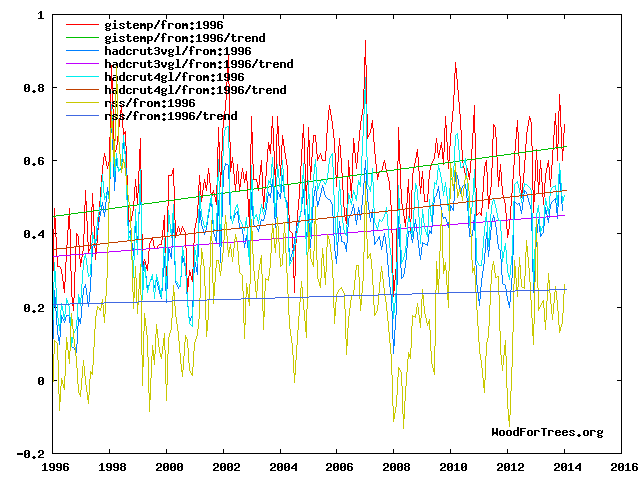
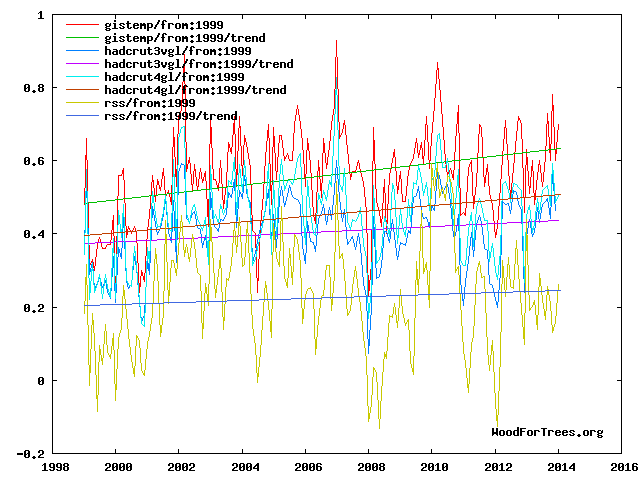
UV irradiance? Has UV irradiance changed significantly over the past 100 years? Has it increased or decreased? How does it affect climate?
Ionized particles? Heliospheric fluctuations? Solar and geo magnetics? Cosmic ray fluctuations? Have these things changed appreciably in the past 100 years? The past 50? How do you think they might affect global temperatures?
Bio off-gassing? Not sure what you mean but it's pretty clear that increasing CO2 levels are almost entirely the result of human activity. Unless you think that something has caused natural levels to go out of balance.
Hydrological cycling fluctuations? You mean precipitation and such? Isn't that more a result of warming than a cause?
You seem to think that these factors have not been taken into account.
Tell me, what happens to the trend lines if you start after the intense El Nino of 1998, or before? Starting with that big peak sort of skews it a bit. Here, I'll show you:
From your same source, here's a look at the 17 year pause thus far:


What if it does?
What if this pause continues for another 17 years ?
That would be good.
What if their estimated warming trend predicted through to 2100 never comes back to full fruition ?
The IPCC does not say the Sun has a "minimal effect." It is, in fact, solar radiation which drives climate. What the IPCC report(s) say is that there has not been enough variation in total solar irradiance to account for the increase in temperatures over the past 100 years. The IPCC says that volcanic activity is likely to be partially responsible for the flattening, as has the slight reduction in solar activity, as has other factors. It's not rediculous at all, climate is not simple, it is subject to many internal variables.
And since the sun has such a "minimal effect" on our climate (per IPCC AR reports), are the mysterious workings of volcanoes to blame for these past 17 years ? Surely, you see how ridiculous this sounds just like I do.
Radio flux? How does radio flux affect climate?
- Solar radio flux
- UV irradiance
- Oceanic volcanism
- Ionized particles
- Heliospheric fluctuations
- Solar and geo magnetics
- Cosmic ray fluctuations
- Bio off-gassing
- Hydrological cycling fluctuations
UV irradiance? Has UV irradiance changed significantly over the past 100 years? Has it increased or decreased? How does it affect climate?
Ionized particles? Heliospheric fluctuations? Solar and geo magnetics? Cosmic ray fluctuations? Have these things changed appreciably in the past 100 years? The past 50? How do you think they might affect global temperatures?
Bio off-gassing? Not sure what you mean but it's pretty clear that increasing CO2 levels are almost entirely the result of human activity. Unless you think that something has caused natural levels to go out of balance.
Hydrological cycling fluctuations? You mean precipitation and such? Isn't that more a result of warming than a cause?
You seem to think that these factors have not been taken into account.
reply to post by luxordelphi
"Even though we can't find anything, it would be neat if we could."
You know that both Neptune and Pluto have very long "years" right? You know that Earth's climate changes at different times of its year, right? It's turning summer for Neptune's southern hemisphere.
How do you know? That article talks about the brightening of Neptune's atmosphere, not warming. Also, as much as they would like to find a correlation to Earth's climate, they can't.
Neptune is also experiencing global warming.
onlinelibrary.wiley.com...
Although correlations between Neptune's brightness and Earth's temperature anomaly—and between Neptune and two models of solar variability—are visually compelling, at this time they are not statistically significant due to the limited degrees of freedom of the various time series. Nevertheless, the striking similarity of the temporal patterns of variation should not be ignored simply because of low formal statistical significance.
"Even though we can't find anything, it would be neat if we could."
You know that both Neptune and Pluto have very long "years" right? You know that Earth's climate changes at different times of its year, right? It's turning summer for Neptune's southern hemisphere.
hubblesite.org...
Here we describe new HST observations in 2002, which confirm a continuing increase in Neptune’s reflectivity and establish new constraints on its spectral and spatial characteristics. We show that the recent increase is mainly produced by changes in restricted latitude regions and that the long-term variation follows a simple phase-shifted seasonal model.
The declining solar cycle. Short term internal processes, like ENSO.
And, finally, a post question: if tiny volcanoes are responsible for, perhaps, up to 15% of the hiatus, what is responsible for the rest?
edit on 3/1/2014 by Phage because: (no reason given)
reply to post by FriedBabelBroccoli
Sigh.
You take one statement out of context and throw the baby out with the bath water. By closed system he means once heat gets in, it doesn't get out again. It's more likely a failing of the news reporter to fully understand and correctly report this sciencey stuff than the professor being an idiot.
Here's a video with pretty pictures that explains what the good professor means.
Sigh.
You take one statement out of context and throw the baby out with the bath water. By closed system he means once heat gets in, it doesn't get out again. It's more likely a failing of the news reporter to fully understand and correctly report this sciencey stuff than the professor being an idiot.
Here's a video with pretty pictures that explains what the good professor means.
new topics
-
Should be BANNED!
General Chit Chat: 35 minutes ago -
Signing back up
Introductions: 8 hours ago
top topics
-
And Here Come the Excuses!!
General Conspiracies: 16 hours ago, 18 flags -
Drones over New Jersey
Aliens and UFOs: 17 hours ago, 8 flags -
Signing back up
Introductions: 8 hours ago, 5 flags -
Should be BANNED!
General Chit Chat: 35 minutes ago, 0 flags
active topics
-
-@TH3WH17ERABB17- -Q- ---TIME TO SHOW THE WORLD--- -Part- --44--
Dissecting Disinformation • 3603 • : duncanagain -
Should be BANNED!
General Chit Chat • 0 • : Flyingclaydisk -
Post A Funny (T&C Friendly) Pic Part IV: The LOL awakens!
General Chit Chat • 7897 • : Flyingclaydisk -
And Here Come the Excuses!!
General Conspiracies • 87 • : Flyingclaydisk -
ILLUMINATION – Reverse Perception Of Cyclic Probability – CEO ASSASSINATION
Secret Societies • 15 • : Compendium -
Thank you to people who said they were going to do something to people they found voted for Trump.
US Political Madness • 25 • : GotterDameron23 -
As dictator of health care
Medical Issues & Conspiracies • 18 • : billxam1 -
Signing back up
Introductions • 16 • : GENERAL EYES -
music for the apocalypse
Music • 24 • : annonentity -
Rant. I am sick of people saying the police are revenue raising.
Rant • 4 • : inflaymes69
